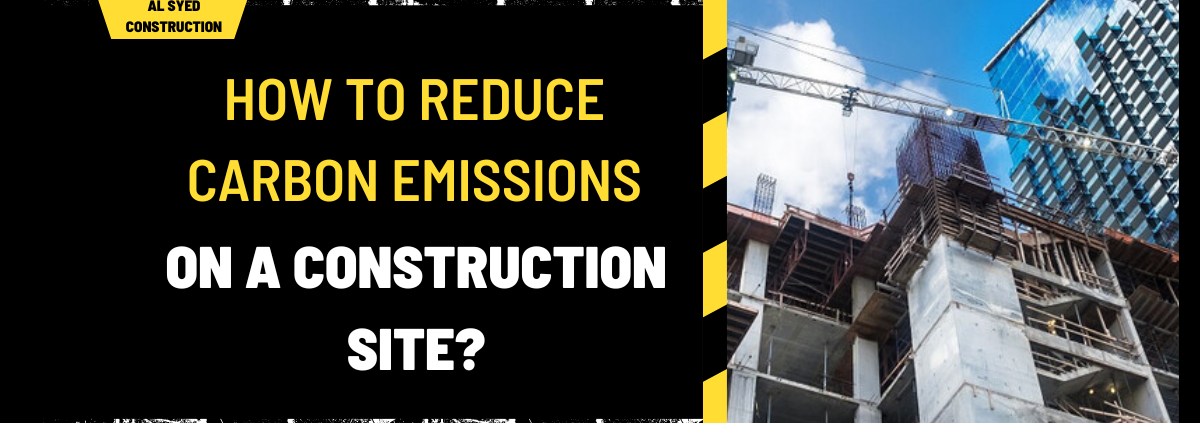How to Reduce Carbon Emissions on a Construction Site?
Introduction
Reducing carbon emissions on construction sites is essential for meeting environmental goals and regulatory requirements. As the construction industry contributes significantly to greenhouse gas emissions, adopting effective strategies to minimize these emissions is critical for sustainability and environmental stewardship. This comprehensive guide explores actionable strategies to reduce carbon emissions on construction sites, helping to enhance eco-friendly practices in building projects.
Understanding Carbon Emissions in Construction
Carbon emissions in construction primarily stem from activities such as the use of heavy machinery, transportation of materials, and energy consumption during construction processes. By addressing these sources, construction firms can significantly lower their carbon footprint and contribute to a greener industry.
1. Optimize Equipment and Machinery Usage
1.1. Use Energy-Efficient Machinery
Investing in energy-efficient construction equipment is a fundamental step in reducing carbon emissions. Modern machinery, such as hybrid and electric construction vehicles, offers improved fuel efficiency and lower emissions compared to traditional diesel-powered equipment.
1.2. Implement Equipment Maintenance Programs
Regular maintenance of machinery ensures that equipment operates at peak efficiency, reducing fuel consumption and emissions. Implementing a proactive maintenance program can prevent breakdowns and optimize performance, contributing to lower carbon emissions.
1.3. Use Smart Technology for Equipment Management
Incorporate smart technology and telemetry systems to monitor and manage equipment usage. These technologies provide real-time data on fuel consumption and operational efficiency, allowing for better decision-making and reduction in unnecessary emissions.
2. Reduce Energy Consumption
2.1. Adopt Renewable Energy Sources
Integrating renewable energy sources such as solar panels or wind turbines on construction sites can significantly reduce reliance on fossil fuels. Using renewable energy for site operations and temporary facilities helps lower the overall carbon footprint.
2.2. Enhance Site Energy Efficiency
Improving the energy efficiency of site facilities, including lighting and heating, can reduce overall energy consumption. Utilize energy-efficient lighting and insulation materials to minimize energy use and associated emissions.
2.3. Implement Energy Management Systems
Employ energy management systems to track and optimize energy usage across the construction site. These systems help identify areas of high consumption and provide insights for reducing energy use and emissions.
3. Optimize Material Usage
3.1. Choose Low-Carbon Materials
Select low-carbon construction materials such as recycled steel, bamboo, or low-impact concrete. These materials have a reduced carbon footprint compared to conventional options, contributing to overall emission reductions.
3.2. Reduce Waste Through Efficient Planning
Implement waste reduction strategies such as accurate material forecasting and efficient cutting plans. By minimizing material waste, you reduce the need for additional production and transportation, thereby lowering carbon emissions.
3.3. Recycle and Reuse Materials
Promote material recycling and reuse on site. Salvaging and reusing materials from previous projects or local sources helps reduce the demand for new materials and decreases transportation-related emissions.
4. Enhance Transportation Efficiency
4.1. Optimize Logistics and Delivery Routes
Plan and coordinate material deliveries to minimize transportation distances and reduce emissions. Use logistics software to optimize delivery routes and schedules, ensuring efficient transportation with minimal environmental impact.
4.2. Use Low-Emission Vehicles
Where possible, choose low-emission or electric vehicles for transporting materials and equipment. Transitioning to cleaner transportation options helps decrease the overall carbon emissions associated with site operations.
4.3. Implement Site-Wide Transportation Policies
Develop and enforce transportation policies that encourage the use of public transport, carpooling, and other sustainable travel options for site personnel. Reducing the number of single-occupancy vehicles on site can significantly lower emissions.
5. Promote Sustainable Site Practices
5.1. Implement Green Building Practices
Adopt green building practices and certifications, such as LEED or BREEAM, which focus on reducing environmental impacts. Incorporating these practices into your construction projects ensures a commitment to sustainability and emission reduction.
5.2. Educate and Train Site Personnel
Provide training for site personnel on sustainable practices and carbon reduction techniques. Educating workers about the importance of reducing emissions and how they can contribute to these efforts fosters a culture of environmental responsibility.
5.3. Monitor and Report Emissions
Establish a system for monitoring and reporting carbon emissions on site. Regularly track emissions data to identify trends, assess the effectiveness of reduction strategies, and make necessary adjustments to improve performance.
6. Implement Sustainable Construction Methods
6.1. Use Modular Construction Techniques
Modular construction reduces waste and energy use by prefabricating building components off-site. This method lowers emissions associated with on-site construction and transportation, contributing to overall sustainability.
6.2. Emphasize Energy-Efficient Building Design
Incorporate energy-efficient design principles into construction projects. Designing buildings to maximize natural light, ventilation, and insulation can reduce the need for artificial heating and cooling, leading to lower energy consumption and emissions.
6.3. Promote Passive Solar Design
Integrate passive solar design strategies to optimize natural heating and cooling. Utilizing building orientation, shading, and thermal mass can reduce reliance on mechanical systems and lower carbon emissions associated with energy use.
Conclusion
Reducing carbon emissions on construction sites is a critical step towards achieving sustainability and environmental responsibility. By optimizing equipment usage, reducing energy consumption, and implementing sustainable practices, construction firms can significantly lower their carbon footprint. Embracing these strategies not only benefits the environment but also enhances project efficiency and contributes to long-term cost savings.



